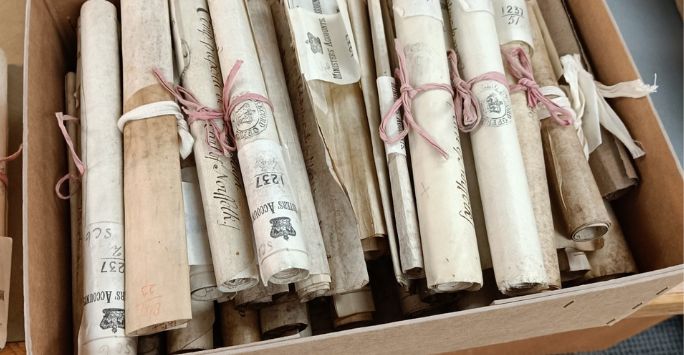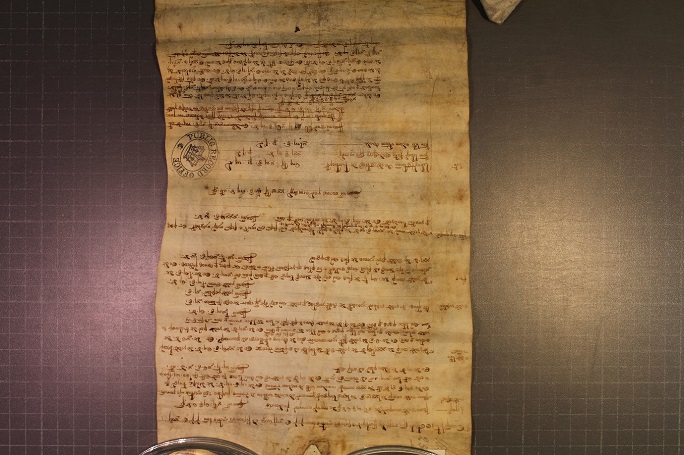
This month, June 2022, is the 100-year anniversary of the gelignite explosion at the Record Treasury in the Four Courts, Dublin during the Irish Civil War. Thousands of manuscripts and documents from seven centuries of Irish history were destroyed. A very few survived on the day. But others survived by being held in other locations. Here, Dr Stephen Hewer of the Institute of Irish Studies discusses one such manuscript.
There are several types of medieval records that were made. One of the oldest types of records in general and one of the most numerous is financial accounts. The practice by powerful people of keeping meticulous records of their wealth is what allows a great deal of the social research into medieval societies. Regular people do not often appear in royal letters, praise poems or law tracts, but they do appear in manorial extents and rentals.
The document I am introducing today is from the accounts of Roger Bigod (c.1245-1306), count of Norfolk, marshal of England and lord of the liberty of Carlow. Roger is famous among many British medievalists for his interactions with Edward I of England but the focus here in on what Roger’s financial records call tell us about people in medieval Ireland. The reason that these accounts survive is because of the famous interactions with Edward though. To pay off some large debts, Roger agreed to surrender all of his properties to the crown of England upon his death and with Roger’s properties came his financial records. Now these accounts are held by the UK National Archives in the series SC 6/1237-1239.
Within the box (in the first picture) is one particular roll, SC 6/1237/50 https://discovery.nationalarchives.gov.uk/details/r/C5969093. It is the provost’s account (‘compotus’) for Castle Fochrid (probably was located where Castlemore, Co. Carlow is now) the term 13-14 Edward I: Michaelmas 1284 to Michaelmas 1285. This was standard procedure for financial records. The royal exchequer in England maintained the Michaelmas-to-Michaelmas (29 Sept.-29 Sept.) term instead of matching the regnal terms that changed with every monarch. A provost was the person in charge of the manor or castle who collected the rents, arrested people or their goods for payment, and delivered the accounts of all income and expenses back to the lord at the end of the term. The provost also regularly interacted with the treasurer of the liberty of Carlow, Thomas Wade.

SC 6/1237/50: Account for Castle Fochrid
Like many of these accounts in SC 6/1237, this particular manuscript is lined. The clerks who were making the accounts, probably at the treasury for the entire liberty, on behalf of all of the provosts and bailiffs had lined the parchment. It was standard in the thirteenth century to have a margin on the left-hand side for subheadings, then a central main text, and occasionally right-hand margin for notes (here, the ‘summa’ or totals of amounts received, owed, or paid). The line for the right-hand margin is not visible on this manuscript, but it is on others in this series. The lines for the main text were not always followed as additional information was needed in certain entries and so sometimes there are two rows of texts within the lines.

‘Compotus Johannis OGlagh prepositi Castri de Fochrid’
The biggest discovery from this particular account is the provost. The provost for Castle Fochrid for 1284-1285 was ‘Johannes OGlagh’. He was almost certainly a Gaelic man with the surname Óglagh or possibly Mac an Óglaigh. He would have had bailiffs or sergeants serving under him and clerks writing up his expenses and receipts. He had a great deal of arrears to collect from the previous term – it does not specify whether he was the provost in the previous term or someone else – and would have spent considerable time going around to houses to collect rents. He also delivered the issues from the hundred court indicating that he ran the court. Hundred courts relied a great deal on customary law and so he would not have required ‘common law’ legal training. He almost certainly was intimately familiar with the court processes and probably was picked to be provost as a leading resident of the area who would have been called to be a juror in the court from adulthood.
John/Seán Óglagh was not alone. There are dozens of Gaelic provosts, bailiffs and sergeants in the surviving records (see Hewer, Beyond Exclusion in Medieval Ireland, pp 85-91), which means that many more have escaped our sight through the loss of records over time. John/Seán was also not the only Óglagh with power in medieval English Ireland. Hugh Oglawth and Adam Oglauth were attorneys in the Dublin Bench. Other people named Óglagh held free lands, granted away lands or rents (making them a lord), and were on the Dublin Guild Merchant Roll. A ‘John Oglath’ was sued for a house near Dublin in 1299. It is possible this was the same man, but equally possible to be a different person as well.
Surviving originals like the SC 6/1237 series are a great source for the history of medieval Ireland. We should also remember that many copies of records were made before 1922 (such as the RC 7 and RC 8 series at The National Archives of Ireland) and these records are similarly full of hidden/forgotten information about Ireland. There is a lot more left to discover.